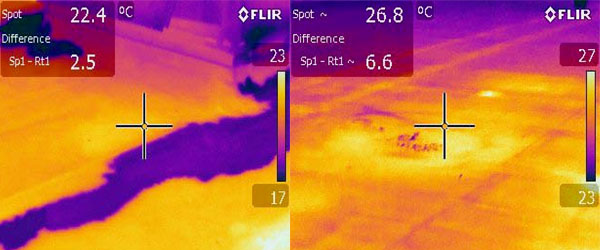It’s a common occurrence: issues with your business’s roof will occur not only when you least expect them to, but also at the most inopportune moment. Roof leaks and their resulting damage requires much effort, cost, and time to rectify. However, there is one way to prevent these issues from occurring, and that is with something called an infrared roof inspection.
How Infrared Roof Inspection Works
An infrared roof inspection uses infrared thermography (IR) to detect trapped moisture on a roof’s surface. It is a diagnostic tool which displays the different areas of a roof in terms of their temperature. This part of the spectrum is not visible to the human eye but with the camera appears as a range of bright colors.
 The presence of moisture will be instantly evident in an IR image, as moist areas release heat absorbed during the day far slower than dry areas do. Once identified, these areas of higher moisture can be investigated further for damage which may be promoting the growth of mold or future structural problems as well as heat loss.
The presence of moisture will be instantly evident in an IR image, as moist areas release heat absorbed during the day far slower than dry areas do. Once identified, these areas of higher moisture can be investigated further for damage which may be promoting the growth of mold or future structural problems as well as heat loss.
The result of an IR roof inspection will tell you where moisture is sitting on your roof, and where issues with mold are most likely to occur. In having an IR inspection done, issues can be identified well before they threaten the integrity of your roof, the safety of your building and the health of your employees. Depending on what is discovered, commercial roof repair may be needed.
How IR Roof Inspection Can Benefit Your Business
IR inspection is a valuable part of roof maintenance, and is strongly recommended whenever you purchase, sell, or lease a building. In having this kind of maintenance done, you can ensure that your building’s structure isn’t carrying the additional weight of moisture, which can cause significant structural damage over time.
An IR inspection prevents the interior of your building from damage due to moisture, which can threaten equipment and human health. IR inspections are also incredibly accurate, can be completed very quickly, and are non-invasive.
Roof Materials Play a Role
The best candidates for IR inspection are those roofs made from common materials such as composite board, fiberglass, polystyrene, and organic fibers. Other roof materials such as gypsum or highly reflective roofs can make it more difficult for IR images to be read.
Unfortunately, some types of roof construction, such as inverted roofs where polystyrene insulation exists between the protective membrane and the ballast are not suitable for IR inspection.
Optimal Weather Conditions
IR roof inspections do have minimum weather requirements. This kind of inspection is best conducted when:
- Inspection day’s weather has been mostly sunny
- The surface of the roof is dry at sunrise
- No rain has fallen on the day of inspection
- Daytime temperatures are higher than 40ºF
- The IR inspection must be done 1½ – 2 hours after sundown.
A preliminary survey will be conducted by commercial roof installation professionals prior to the actual inspection day. This is done in order to gauge your roof’s response to weather.
A Vital First Step
An infrared thermography roof inspection is an initial, incredibly important step in roof maintenance. Once the scan is complete, the image is read by a trained professional, and then verified using other equipment and software. The image obtained from an IR camera can also be used to make the understanding of any issues easier for you as the building’s owner.

An IR roof inspection is a cost-effective solution to solving roof problems. In having an inspection done early on, the cost of complete roof replacement or structural damage repair can be completely avoided.
